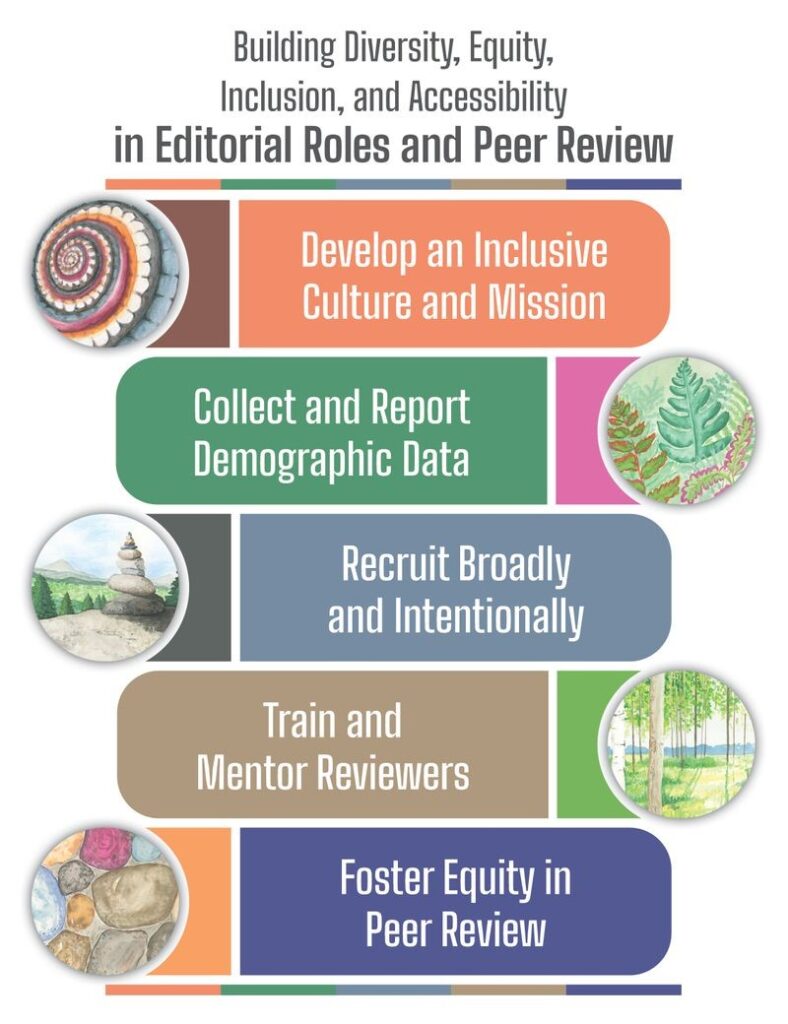Although most scholarly journal editors/publishers recognize the value of DEIA (diversity, equity, inclusion, and accessibility) among their associate editors and editorial boards, it can be overwhelming to constitute a new editorial board or change a long-established one in which diversity has not been included. Editors need advice and practical suggestions regarding the actions they can take to diversify their boards and promote equity in peer review. The latest toolkit in the Coalition for Diversity in Scholarly Communications (C4DISC) Toolkit for Equity series, A Focused Toolkit for Journal Editors and Publishers: Building DEIA in Editorial Roles and Peer Review,1 was released Tuesday, May 7, 2024, on the C4DISC website. The toolkit was authored by members of the Society for Scholarly Publishing’s DEIA Committee.
The toolkit recommends “practical and relevant actions for editors and publishers to take to create broad representation on editorial boards and to ensure fairness and minimization of bias in the peer review process.” The following is a brief summary of the major sections of the toolkit.
Five major recommendations explored in the toolkit are reflected in the infographic (Figure).

Recommendation 1
The first recommendation outlines actions to help develop an inclusive culture and mission. One of the first steps is an editorial commitment to create a diversity statement and to consider publishing it along with an editorial committing to addressing inequities in the field. In selecting an editorial board, suggested actions include setting goals for diverse representation, including new people in the editorial process, and appointing one or more dedicated associate editors or editorial board members to review papers for compliance with DEIA language and policies. Other actions include promoting data sharing and open access for all researchers to use and setting baseline standards for inclusive language and reporting.
Recommendation 2
The second recommendation details steps for collecting and reporting demographic data of those involved in the editorial process to guide goal-setting and subsequent actions to improve diversity. Suggestions include gathering baseline demographic data. One of the first challenges is deciding which terms to use and the methods for gathering data, keeping in mind that demographic data needs to be gathered in a way that respects privacy, including intentionally gathering explicit consent, anonymizing data, and only reporting aggregate data. Because security is essential, access to data must be limited to only necessary staff. The toolkit suggests targeting editors and editorial board members first to try out the methods.
Recommendation 3
The third recommendation advises on recruiting broadly and intentionally for both editorial roles and reviewers. Suggestions include thoughtfully considering the criteria you list, including considering characteristics, background, and core strengths rather than teachable skills or acquired positions, when posting position descriptions. Further recommendations include using neutral, clear language and avoiding biasing terminology, conducting a group review of calls for nominations and role descriptions to get different perspectives on whether the language could be biasing, and enabling open calls for nomination and self-nomination to encourage candidates who may not have been identified to apply.
More suggestions from Recommendation 3 include recruiting intentionally to persistently marginalized communities, identifying prospective candidates from speakers or reliable reviewers, and considering ways to make selection and interview processes more fair and transparent—with diverse committees and standardized questions. When setting up an editorial board, create alternative opportunities for early-career researchers to gain editorial experience and seek them out to participate on editorial boards. This includes creating roles for guest editors and section editors, budgeting editorial fellowships to create an opportunity for early career researchers from diverse backgrounds, and providing opportunities for additional professional development, such as writing and editing editorials, book reviews, or blog postings.
Recommendation 4
The fourth recommendation suggests creating ways to train and mentor reviewers. Suggestions include providing accessible learning tools (e.g., resources such as the American Psychological Association: “Learn How to Review a Manuscript”2), developing peer review mentorship programs and allowing for coreviewing, providing feedback to reviewers, placing “Calls for Reviewers” on your journal website, and ensuring your journal’s content is accessible and easily read by a screen reader.
Recommendation 5
Finally, the fifth recommendation provides education and training actions and models to increase equity in the peer review process itself. Suggestions include providing bias awareness or diversity training for editors and reviewers, educating editors on resources that promote diverse research methods and transparent reporting standards, and promoting style guides on avoiding bias in language. Other ideas include coaching reviewers to be on the lookout for noninclusive language.
The recommendation provides some guidelines and ideas about exploring alternative peer review models, such as double-anonymous and triple anonymous peer reviewing, and encouraging reviewers to disclose if anyone assisted them in a mentoring relationship and offering credit to those who assisted. Considering diverse, multistep editor decisions to minimize bias is also discussed, along with developing annual reporting to assess potential bias throughout the peer review process.
I encourage you to read the toolkit in detail and focus on the recommendations that you believe your editors are ready to implement. All new editors like to be seen as innovative and progressive when they take the reins. Finally, it’s important to remember that all authors should be beneficiaries of equitable peer review. Feedback during the peer review process results in strengthening results, designing future research and, in the case of medical journals, improving patient care.
Translations of this toolkit in Spanish and Portuguese will be coming soon.
References and Links
- Coalition for Diversity in Scholarly Communications. A focused toolkit for journal editors and publishers: building DEIA in editorial roles and peer review. [accessed August 21, 2024]. https://c4disc.pubpub.org/toolkit-editors-and-publishers.
- American Psychological Association. Learn how to review a manuscript. [accessed August 21, 2024]. https://www.apa.org/pubs/journals/resources/how-to-review-manuscripts.
Patricia K Baskin, MS (https://orcid.org/0000-0002-9850-4391) is Deputy Chief, Publications, American Academy of Neurology.
